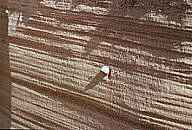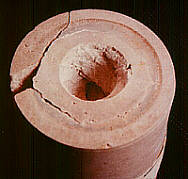Cross Strata Anomalies
Contents
Configuration of Cross Strata Around PebblesFlume Experiments with Pebbles
More Anomalies
Discussions
Composition of the Drift
Rock Disintegration
Expansion Effects in the Drift
Robert Jameson on Conglomerates
Related Links
Configuration of Cross Strata Around Pebbles
 There
is no sign of deflection of the cross strata around embedded pebbles in
cross stratified drift, that would be expected due to stoss and lee effects.
In an environment of rapid current flow, erosion of a horseshoe-shaped
trough occurs on the stoss side of the pebbles, and elongated ridges
form on the lee side, parallel to the current direction, but these effects
seem to be absent in typical exposures of cross strata in drift and sandstone,
where pebbles are present.
There
is no sign of deflection of the cross strata around embedded pebbles in
cross stratified drift, that would be expected due to stoss and lee effects.
In an environment of rapid current flow, erosion of a horseshoe-shaped
trough occurs on the stoss side of the pebbles, and elongated ridges
form on the lee side, parallel to the current direction, but these effects
seem to be absent in typical exposures of cross strata in drift and sandstone,
where pebbles are present.
 If
it formed as a sediment, the presence of pebbles in sandy cross stratified
beds would also cause bumps and wavyness in the cross strata, due to the
elongated ridges or flutings on the lee side of the pebbles in the vicinity,
but these effects are generally not present. This seems anomalous if the
cross strata was formed in a sedimentary environment where rapid currents
produced the cross strata and transported the pebbles.
If
it formed as a sediment, the presence of pebbles in sandy cross stratified
beds would also cause bumps and wavyness in the cross strata, due to the
elongated ridges or flutings on the lee side of the pebbles in the vicinity,
but these effects are generally not present. This seems anomalous if the
cross strata was formed in a sedimentary environment where rapid currents
produced the cross strata and transported the pebbles.
Lack of the stoss and lee effects around embedded pebbles is a prediction of the disintegration theory. In this theory, the drift formed by a disintegration mechanism, and laminations of cross strata mark the successive surfaces of disintegration. No currents were involved, so there would be no stoss and lee effects around embedded pebbles.
Flume Experiments with Pebbles
 An
experiment in a flume where sand was deposited by rapid currents, and where
dunes and ripples were formed, is illustrated in the photo at right. This
shows the sandy strata near a pebble just introduced at the glass walls
of a flume, where a rapid current flows from right to left. Immediately
after the pebble was introduced, erosion occurred on the stoss side of
a pebble, and deposition on the lee side. Burial followed rapidly. The
strata is less distinct than in natural cross stratified drift, and concave
downwards patterns are common. This contrasts with the cross strata of
the drift and sandstones. Grading by grain size is also evident. The patterns
of cross strata in sediments such as this differ from those of the drift
from which the sand was obtained.
An
experiment in a flume where sand was deposited by rapid currents, and where
dunes and ripples were formed, is illustrated in the photo at right. This
shows the sandy strata near a pebble just introduced at the glass walls
of a flume, where a rapid current flows from right to left. Immediately
after the pebble was introduced, erosion occurred on the stoss side of
a pebble, and deposition on the lee side. Burial followed rapidly. The
strata is less distinct than in natural cross stratified drift, and concave
downwards patterns are common. This contrasts with the cross strata of
the drift and sandstones. Grading by grain size is also evident. The patterns
of cross strata in sediments such as this differ from those of the drift
from which the sand was obtained.
More Anomalies
The distinct, smooth patterns of laminations in many cross stratified formations (drift and sandstone) may be anomalous. This distinct pattern is not seen in sediments formed in flume experiments, even if the same sand is used. Laminations formed in sediments are less smooth and less distinct. They also tend to be distorted by compaction.Discussions
Some discussions about the cross strata anomalies on the talk.origins newsgroup:| Re: A Visit to the ICR, Part 5 | 1998/05/23 | Douglas Cox |
| Re: A Visit to the ICR, Part 5 | 1998/05/26 | Andrew MacRae |
| Cross strata anomalies | 1998/06/01 | Douglas Cox |
Composition of the Drift
At the boundary of the Canadian Shield and the Paleozoic limestone cover in eastern Ontario, there is a change in the composition of the drift which mantles the region. Geologic investigations in the region provide an opportunity for comparison of rival theories of origin of the drift, by determining how well the predictions of each fit the data.The limestone bedrock in the area of the Peterborough drumlin field consists of Ordovician calcareous shales and limestones of the Black River and Trenton Groups along with basal sandstones. These overlie Precambrian granite and metasediments.
Across the Shield boundary, the Precambrian pebble content of the drift declines, and the composition of the sand and finer particles changes. Above the limestone bedrock, only about 14% of the pebbles are silicate, the rest are carbonate pebbles, presumably derived locally.
These results are reported by J.G. Cogley and co-workers [See Reference]. In the Abstract, the authors say:
...little of the till covering a portion of central Ontario was carried across the boundary between Precambrian rocks (up-ice) and Paleozoic limestone (down-ice). Seven eighths of the pebble fraction is local, from within 2-5 km of the site of deposition.From the point of view of the glacial interpretation of the drift, these observations seem surprising. The streamlined landforms in the area of their investigation consist of well developed drumlins and flutings, some extremely long. These clearly show the flow directions of the agent of streamlining. If drumlins were shaped by ice sheets, one would expect plenty of pebbles from the Shield to have been carried south and deposited over the limestone, but they are relatively few where they should be abundant.
From the point of view of the disintegration theory, the silicate pebbles and boulders in drift overlying limestone are interpreted as having formed in place, from minor components of the original sediment, or from interbedded units of shale and sandstone, during disintegration of the rock in former catastrophic conditions. Drumlins are believed to have been formed by very rapid currents that streamlined unconsolidated sediments.
The sand fraction in the drift over the limestone regions was on average about 61% non-carbonate, but highly variable, ranging from 100% to 20%. The insoluble component of the limestone bedrock was 5-12%.
The authors reported that limestone pebbles were present in the drift even in areas north of the Shield boundary, which is highly anomalous in a glacial interpretation. About 10% of the larger drift pebbles and 5% of the smaller pebbles were limestone. While this observation is particularly damaging to the glacial explanation, it is easily explained in the disintegration theory; a layer of limestone sediment was disintegrated together with some of the Shield rocks.
References
- Cogley, J.G., M. Aikman, and D.J.A. Stokes, 1997, Allochthonous sediment in till near a lithological boundary in central Ontario, Gèographie Physique et Quaternaìre, vol 51(1).
http://pum12.pum.umontreal.ca/revues/gpq/v51n01/cogley/cogley.html
 Rock
Disintegration
Rock
Disintegration
The photo at right shows a test sample from a rock disintegration experiment.
The rock cylinder was prepared, its ends machined in a lathe, and the sample
was placed in a simple pressure vessel, filled with water. Pressure was
increased, and then rapidly released by opening a valve. The blow-out hole
in the sample was caused by the high pore fluid pressure in the rock, and
rapid flow of pore water towards the release valve, which pulverised the
rock producing a cavity something like a small pothole.
Expansion Effects in the Drift
 This
photo taken in a gravel pit near Cambridge, Ontario, shows a fault in the
drift. The layers of gravel and underlying sand at right has been displaced
upwards relative to the drift at the left. Shearing occurred along a nearly
vertical fault plane. Such evidence for former differential movements within
the drift can be explained by the effects of expansion as the drift formed
by disintegration.
This
photo taken in a gravel pit near Cambridge, Ontario, shows a fault in the
drift. The layers of gravel and underlying sand at right has been displaced
upwards relative to the drift at the left. Shearing occurred along a nearly
vertical fault plane. Such evidence for former differential movements within
the drift can be explained by the effects of expansion as the drift formed
by disintegration.
Movements due to expansion can explain striations on bedrock, and the formation of kames and eskers, in areas where expansion occurred, and where there was resistance from another drift layer, resulting in a pressure ridge of drift gravel and sand being thrust up between them.
Robert Jameson on Conglomerates
Robert Jameson (1774-1854) was the leader of the Neptunists in Britain. The Neptunists promoted the views of Abraham Gottlob Werner (1750-1817), teacher at the school of mines in Freiberg, against the supporters of James Hutton. Jameson went to Freiberg in 1800 and studied under Werner for nearly two years. In 1804 he became professor of Natural History at Edinburgh University.William Buckland, who became Professor of Mineralogy and of Geology at Oxford (later appointed Dean of Westminster), opposed the views of Neptunists like Jameson. In a letter to Greenough, now in the Cambridge University Library, Buckland wrote in 1817:
In Bath I attended two lectures of a young disciple of Jameson, Dr. Galby who is very promising. He gave us Jameson's last theory of the coal formation, which is that all the substance of coal as well as the strata attending it is of chemical origin and unconnected with vegetable matter and that whin dykes are contemporaneous concretions in the rocks they transverse. The whole theory of denudation is to him terra incognita. All pebbles in every species of conglomerate are considered as contemporaneous concretions, with sundry other monstrous opinions which at this time of day astonish me in Jameson.Jameson apparently eventually converted to the views of James Hutton.
Reference
Rupke, N.A. 1983. The great chain of history. Clarendon Press, Oxford. p. 119Related Links
Raphael Pumpelly on secular rock disintegrationThe Destruction and Shattering of the Chalk of Eastern England, by Sir Henry H. Howorth.
The Dislocation and Disintegration of the Chalk in Eastern England and in Denmark, by Sir Henry H. Howorth.
The Chalky and other Post-Tertiary Clays of Eastern England, by Sir Henry H. Howorth.
The So-called Middle Sands and Glacial Gravels of Eastern England, by Sir Henry H. Howorth.
Mystery of Pothole Origins
Pillars, Polystrate Formations, and Potholes